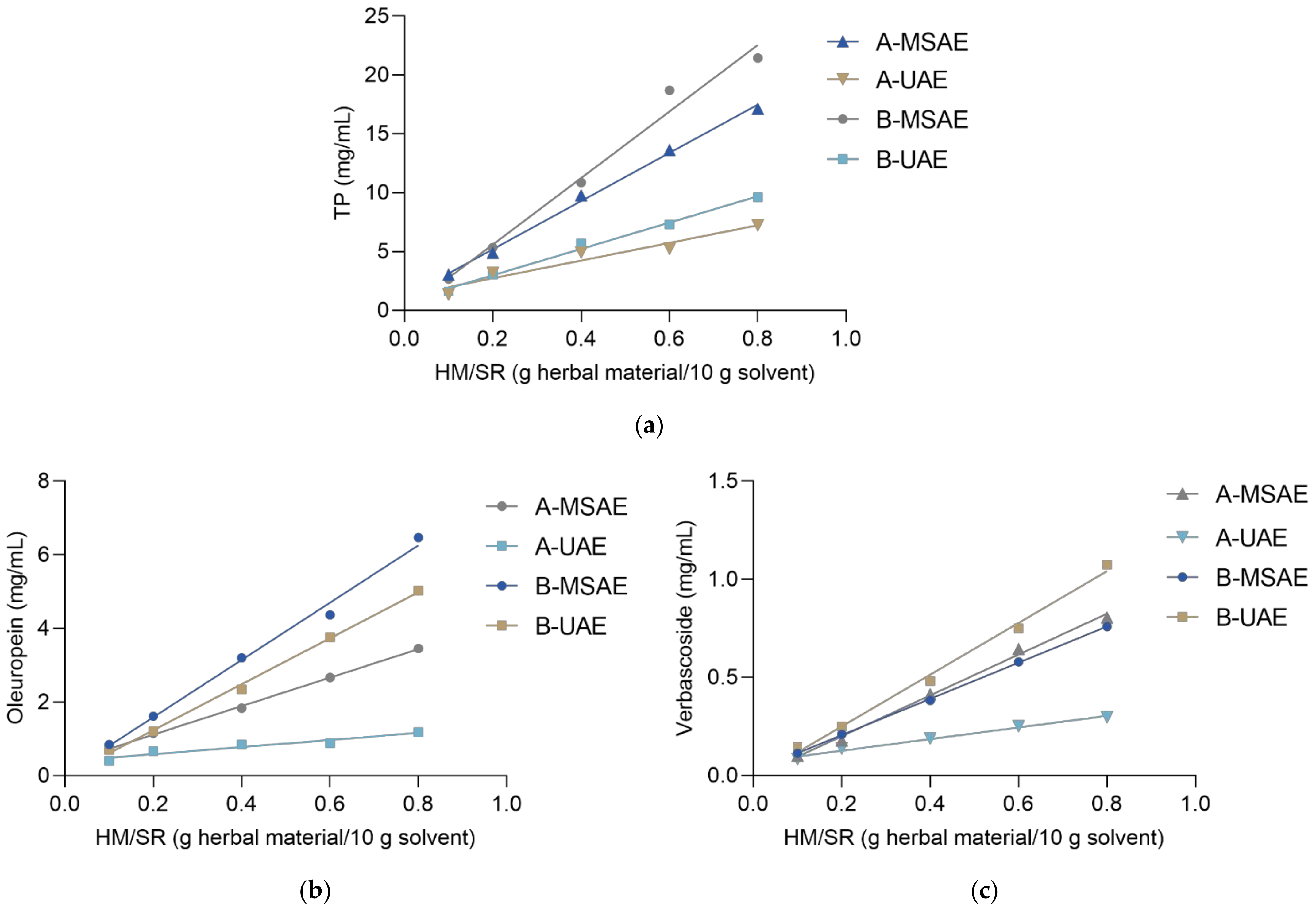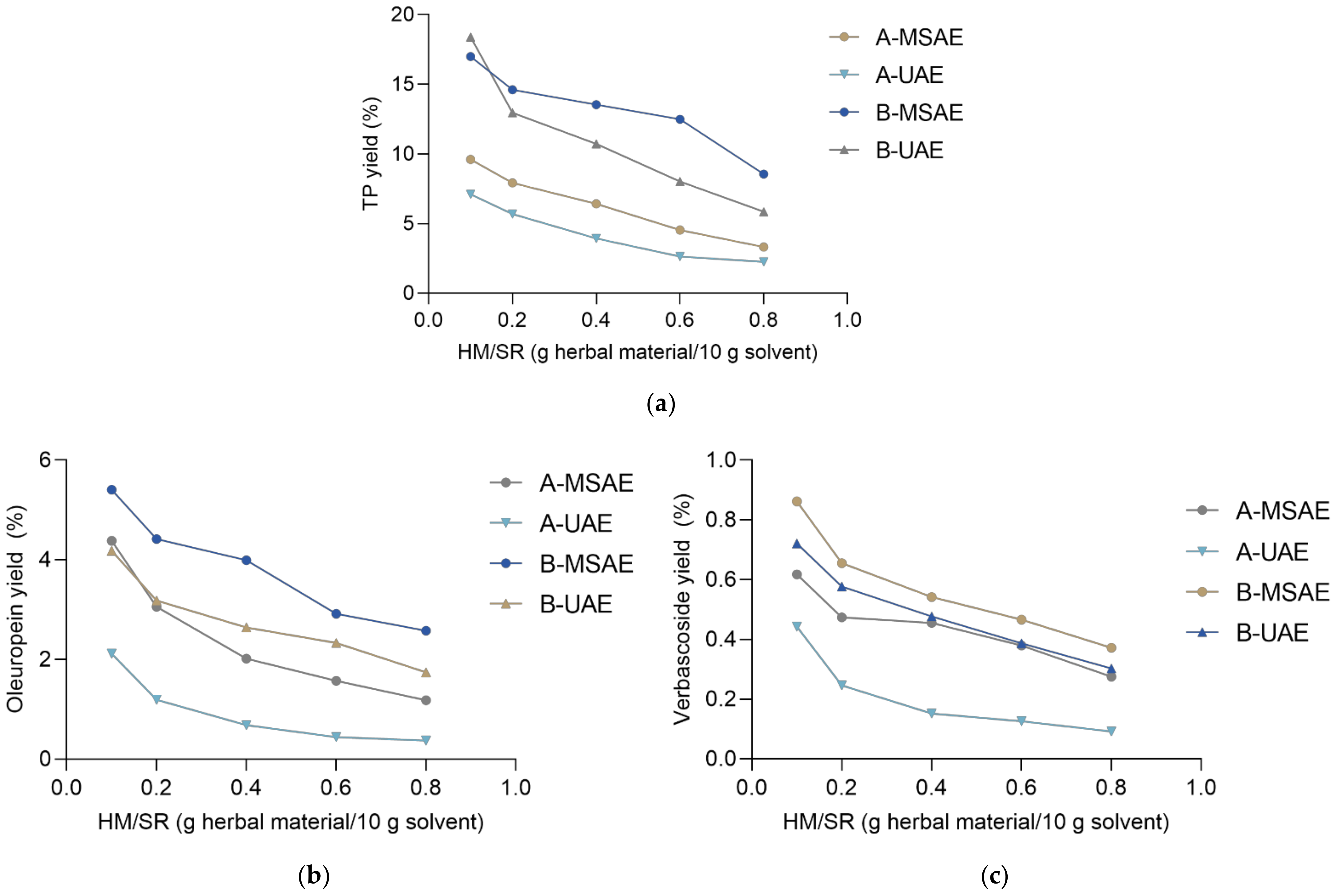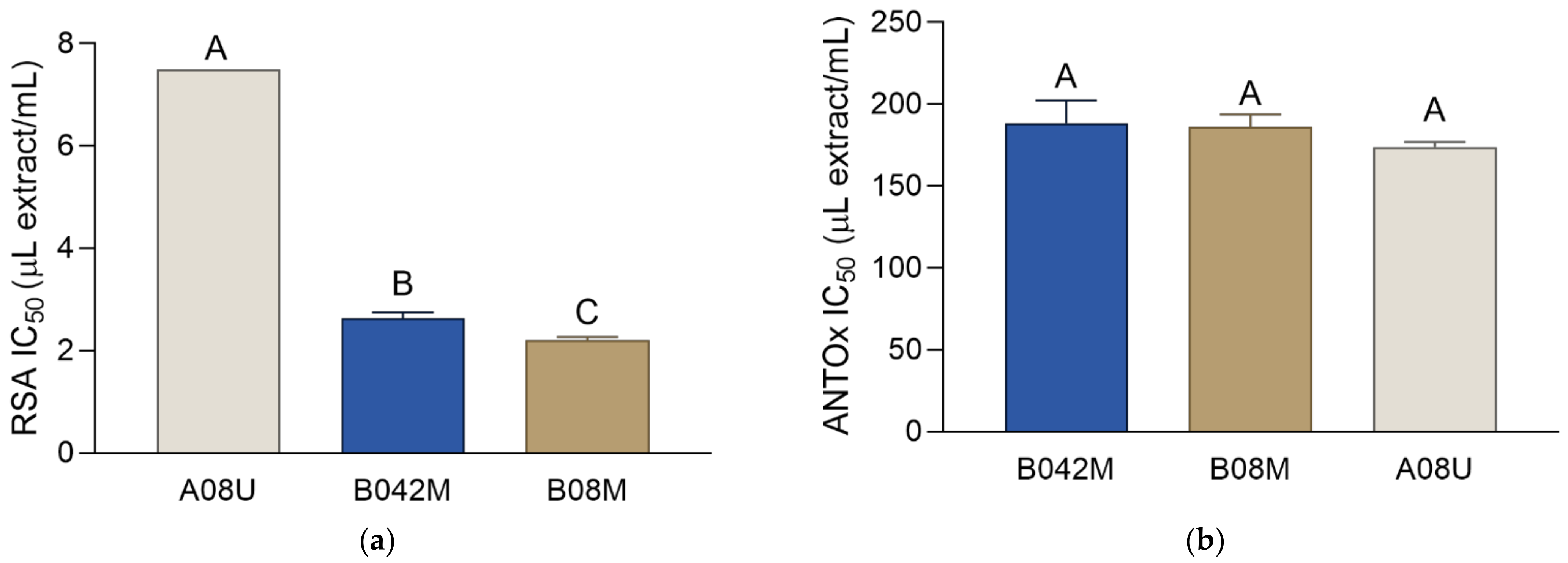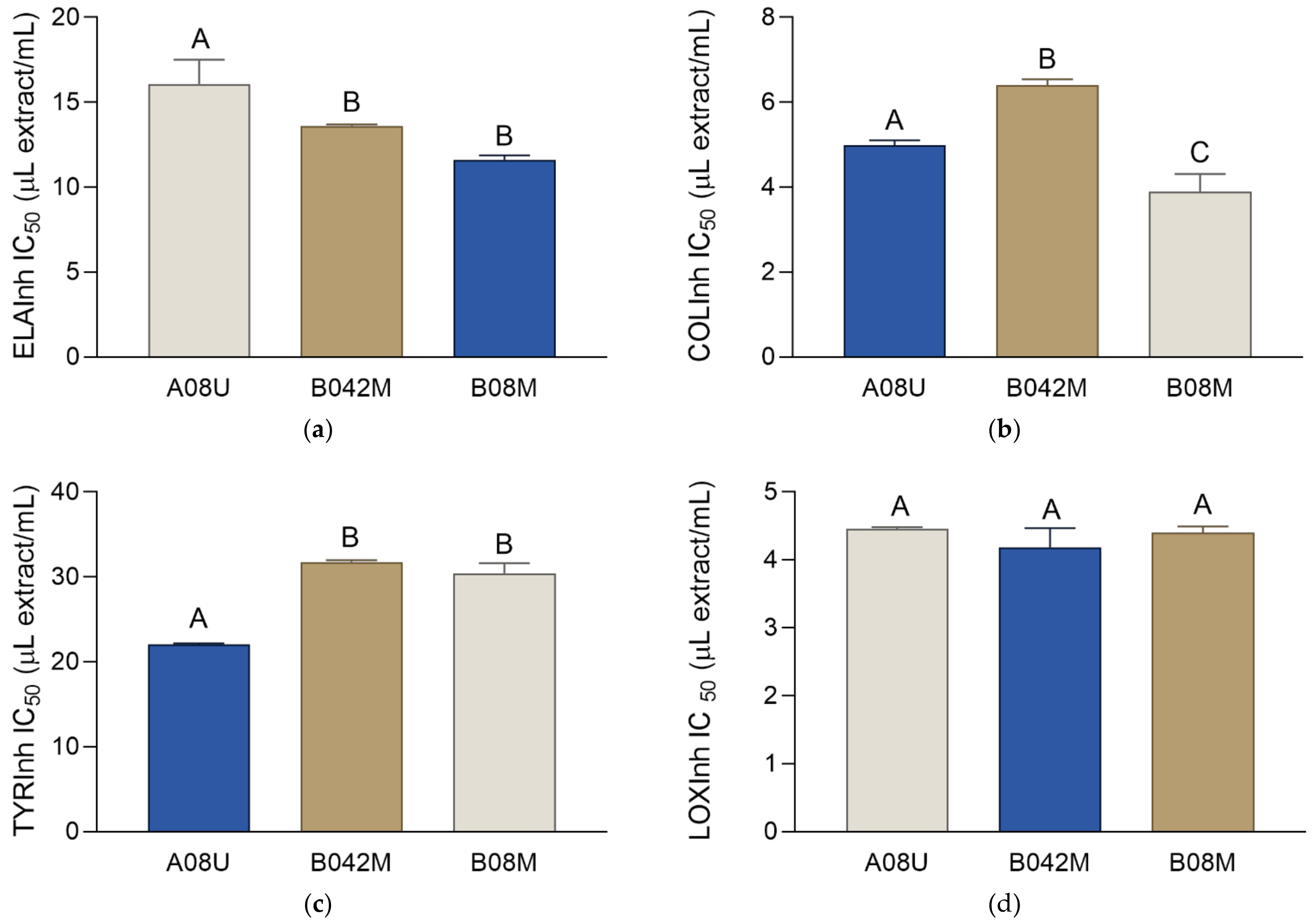Optimization of Bioactive Phenolics Extraction and Cosmeceutical Activity of Eco-Friendly Polypropylene-Glycol–Lactic-Acid-Based Extracts of Olive Leaf
Abstract
1. Introduction
2. Results
2.1. Optimization of the Solvent Composition According to the Mixture Design
2.2. Selection of the Extraction Method
2.3. Preparation and Phytochemical Composition of the Extracts Used for Bioactivity Testing
2.4. Antioxidant Activity
2.5. Enzyme Inhibiting Activity
3. Materials and Methods
3.1. Chemicals
3.2. Plant Material
3.3. Selection of Extraction Solvent
3.4. Kinetic Measurements
3.5. Comparison of UAE and MSAE
3.6. Preparation of the Extracts for Biological Testing
3.7. HPLC-DAD Determination of Oleuropein and Verbascoside Concentration
3.8. Spectrophotometric Determination of Total Phenolic Content
3.9. Spectrophotometric Determination of Total Flavonoid Content
3.10. Spectrophotometric Determination of Total Phenolic Acid Content
3.11. Radical Scavenging Activity
3.12. Antioxidant Activity in β-carotene–linoleic-acid Assay
3.13. Elastase Inhibitory Activity
3.14. Collagenase Inhibitory Activity
3.15. Tyrosinase Inhibitory Activity
3.16. Lipoxygenase Inhibitory Activity
3.17. Statistical Analysis
4. Conclusions
Supplementary Materials
Author Contributions
Funding
Institutional Review Board Statement
Informed Consent Statement
Data Availability Statement
Conflicts of Interest
Sample Availability
References
- Cádiz-Gurrea, M.D.L.L.; Pinto, D.; Delerue-Matos, C.; Rodrigues, F. Olive Fruit and Leaf Wastes as Bioactive Ingredients for Cosmetics—A Preliminary Study. Antioxidants 2021, 10, 245. [Google Scholar] [CrossRef] [PubMed]
- Nediani, C.; Ruzzolini, J.; Romani, A.; Calorini, L. Oleuropein, a Bioactive Compound from Olea europaea L., as a Potential Preventive and Therapeutic Agent in Non-Communicable Diseases. Antioxidants 2019, 8, 578. [Google Scholar] [CrossRef]
- Romani, A.; Ieri, F.; Urciuoli, S.; Noce, A.; Marrone, G.; Nediani, C.; Bernini, R. Health Effects of Phenolic Compounds Found in Extra-Virgin Olive Oil, By-Products, and Leaf of Olea europaea L. Nutrients 2019, 11, 1776. [Google Scholar] [CrossRef]
- Borjan, D.; Leitgeb, M.; Knez, Ž.; Hrnčič, M.K. Microbiological and Antioxidant Activity of Phenolic Compounds in Olive Leaf Extract. Molecules 2020, 25, 5946. [Google Scholar] [CrossRef]
- Arslan, K.; Özant, A.; Özçay, N.; Çalış, İ.; Besim, H. Protoscolicidal Effect of Oleuropein: An in Vitro Study. Turk. J. Surg. 2019, 35, 30–34. [Google Scholar] [CrossRef] [PubMed]
- Vogel, P.; Kasper Machado, I.; Garavaglia, J.; Zani, V.T.; de Souza, D.; Morelo Dal Bosco, S. Polyphenols Benefits of Olive Leaf (Olea europaea L) to Human Health. Nutr. Hosp. 2014, 31, 1427–1433. [Google Scholar] [CrossRef] [PubMed]
- Romani, A.; Mulas, S.; Heimler, D. Polyphenols and Secoiridoids in Raw Material (Olea europaea L. Leaves) and Commercial Food Supplements. Eur. Food Res. Technol. 2017, 243, 429–435. [Google Scholar] [CrossRef]
- Servili, M.; Esposto, S.; Fabiani, R.; Urbani, S.; Taticchi, A.; Mariucci, F.; Selvaggini, R.; Montedoro, G.F. Phenolic Compounds in Olive Oil: Antioxidant, Health and Organoleptic Activities According to Their Chemical Structure. Inflammopharmacology 2009, 17, 76–84. [Google Scholar] [CrossRef] [PubMed]
- Alipieva, K.; Korkina, L.; Orhan, I.E.; Georgiev, M.I. Verbascoside—A Review of Its Occurrence, (Bio)Synthesis and Pharmacological Significance. Biotechnol. Adv. 2014, 32, 1065–1076. [Google Scholar] [CrossRef]
- de Lima Cherubim, D.J.; Buzanello Martins, C.V.; Oliveira Fariña, L.; da Silva de Lucca, R.A. Polyphenols as Natural Antioxidants in Cosmetics Applications. J. Cosmet. Dermatol. 2020, 19, 33–37. [Google Scholar] [CrossRef] [PubMed]
- Tao, Y.; Zhang, Z.; Sun, D.-W. Kinetic Modeling of Ultrasound-Assisted Extraction of Phenolic Compounds from Grape Marc: Influence of Acoustic Energy Density and Temperature. Ultrason. Sonochem. 2014, 21, 1461–1469. [Google Scholar] [CrossRef]
- Santos, J.; Capela, E.; Boal-Palheiros, I.; Coutinho, J.; Freire, M.; Ventura, S. Aqueous Biphasic Systems in the Separation of Food Colorants. Biochem. Mol. Biol. Educ. 2017, 46, 390–397. [Google Scholar] [CrossRef]
- Kawai, F. Microbial Degradation of Polyethers. Appl. Microbiol. Biotechnol. 2002, 58, 30–38. [Google Scholar] [CrossRef]
- Fiume, M.M.; Bergfeld, W.F.; Belsito, D.V.; Hill, R.A.; Klaassen, C.D.; Liebler, D.; Marks, J.G.; Shank, R.C.; Slaga, T.J.; Snyder, P.W.; et al. Safety Assessment of Propylene Glycol, Tripropylene Glycol, and PPGs as Used in Cosmetics. Int. J. Toxicol. 2012, 31, 245S–260S. [Google Scholar] [CrossRef]
- Xu, K.; Xu, P.; Wang, Y. Aqueous Biphasic Systems Formed by Hydrophilic and Hydrophobic Deep Eutectic Solvents for the Partitioning of Dyes. Talanta 2020, 213, 120839. [Google Scholar] [CrossRef]
- Tang, S.-C.; Yang, J.-H. Dual Effects of Alpha-Hydroxy Acids on the Skin. Mol. Basel Switz. 2018, 23, 863. [Google Scholar] [CrossRef]
- Huang, H.-C.; Lee, I.J.; Huang, C.; Chang, T.-M. Lactic Acid Bacteria and Lactic Acid for Skin Health and Melanogenesis Inhibition. Curr. Pharm. Biotechnol. 2020, 21, 566–577. [Google Scholar] [CrossRef] [PubMed]
- Jurasekova, Z.; Domingo, C.; Garcia-Ramos, J.V.; Sanchez-Cortes, S. Effect of PH on the Chemical Modification of Quercetin and Structurally Related Flavonoids Characterized by Optical (UV-Visible and Raman) Spectroscopy. Phys. Chem. Chem. Phys. PCCP 2014, 16, 12802–12811. [Google Scholar] [CrossRef] [PubMed]
- Wang, R.; Pan, F.; He, R.; Kuang, F.; Wang, L.; Lin, X. Arecanut (Areca catechu L.) Seed Extracts Extracted by Conventional and Eco-Friendly Solvents: Relation between Phytochemical Compositions and Biological Activities by Multivariate Analysis. J. Appl. Res. Med. Aromat. Plants 2021, 25, 100336. [Google Scholar] [CrossRef]
- Chakroun, D.; Grigorakis, S.; Loupassaki, S.; Makris, D.P. Enhanced-Performance Extraction of Olive (Olea europaea) Leaf Polyphenols Using L-Lactic Acid/Ammonium Acetate Deep Eutectic Solvent Combined with β-Cyclodextrin: Screening, Optimisation, Temperature Effects and Stability. Biomass Convers. Biorefinery 2021, 11, 1125–1136. [Google Scholar] [CrossRef]
- Kesente, M.; Kavetsou, E.; Roussaki, M.; Blidi, S.; Loupassaki, S.; Chanioti, S.; Siamandoura, P.; Stamatogianni, C.; Philippou, E.; Papaspyrides, C.; et al. Encapsulation of Olive Leaves Extracts in Biodegradable PLA Nanoparticles for Use in Cosmetic Formulation. Bioengineering 2017, 4, 75. [Google Scholar] [CrossRef]
- Rodrigues, F.; Pimentel, F.B.; Oliveira, M.B.P.P. Olive By-Products: Challenge Application in Cosmetic Industry. Ind. Crops Prod. 2015, 70, 116–124. [Google Scholar] [CrossRef]
- Li, Y.; Yu, H.; Jin, Y.; Li, M.; Qu, C. Verbascoside Alleviates Atopic Dermatitis-Like Symptoms in Mice via Its Potent Anti-Inflammatory Effect. Int. Arch. Allergy Immunol. 2018, 175, 220–230. [Google Scholar] [CrossRef]
- Jeirani, Z.; Jan, B.M.; Ali, B.S.; Noor, I.M.; Hwa, S.C.; Saphanuchart, W. The Optimal Mixture Design of Experiments: Alternative Method in Optimizing the Aqueous Phase Composition of a Microemulsion. Chemom. Intell. Lab. Syst. 2012, 112, 1–7. [Google Scholar] [CrossRef]
- Brglez Mojzer, E.; Knez Hrnčič, M.; Škerget, M.; Knez, Ž.; Bren, U. Polyphenols: Extraction Methods, Antioxidative Action, Bioavailability and Anticarcinogenic Effects. Mol. Basel Switz. 2016, 21, 901. [Google Scholar] [CrossRef] [PubMed]
- Vinatoru, M. An Overview of the Ultrasonically Assisted Extraction of Bioactive Principles from Herbs. Ultrason. Sonochem. 2001, 8, 303–313. [Google Scholar] [CrossRef]
- Jacques, R.A.; dos Santos Freitas, L.; Pérez, V.F.; Dariva, C.; de Oliveira, A.P.; de Oliveira, J.V.; Caramão, E.B. The Use of Ultrasound in the Extraction of Ilex Paraguariensis Leaves: A Comparison with Maceration. Ultrason. Sonochem. 2007, 14, 6–12. [Google Scholar] [CrossRef]
- Musa, K.H.; Abdullah, A.; Jusoh, K.; Subramaniam, V. Antioxidant Activity of Pink-Flesh Guava (Psidium guajava L.): Effect of Extraction Techniques and Solvents. Food Anal. Methods 2011, 4, 100–107. [Google Scholar] [CrossRef]
- Albero, B.; Sánchez-Brunete, C.; García-Valcárcel, A.I.; Pérez, R.A.; Tadeo, J.L. Ultrasound-Assisted Extraction of Emerging Contaminants from Environmental Samples. TrAC Trends Anal. Chem. 2015, 71, 110–118. [Google Scholar] [CrossRef]
- Alcántara, C.; Žugčić, T.; Abdelkebir, R.; García-Pérez, J.V.; Jambrak, A.R.; Lorenzo, J.M.; Collado, M.C.; Granato, D.; Barba, F.J. Effects of Ultrasound-Assisted Extraction and Solvent on the Phenolic Profile, Bacterial Growth, and Anti-Inflammatory/Antioxidant Activities of Mediterranean Olive and Fig Leaves Extracts. Molecules 2020, 25, 1718. [Google Scholar] [CrossRef]
- Georgantzi, C.; Lioliou, A.-E.; Paterakis, N.; Makris, D.P. Combination of Lactic Acid-Based Deep Eutectic Solvents (DES) with β-Cyclodextrin: Performance Screening Using Ultrasound-Assisted Extraction of Polyphenols from Selected Native Greek Medicinal Plants. Agronomy 2017, 7, 54. [Google Scholar] [CrossRef]
- Bergeron, C.; Gafner, S.; Batcha, L.L.; Angerhofer, C.K. Stabilization of Caffeic Acid Derivatives in Echinacea purpurea L. Glycerin Extract. J. Agric. Food Chem. 2002, 50, 3967–3970. [Google Scholar] [CrossRef]
- Ciganović, P.; Jakimiuk, K.; Tomczyk, M.; Zovko Končić, M. Glycerolic Licorice Extracts as Active Cosmeceutical Ingredients: Extraction Optimization, Chemical Characterization, and Biological Activity. Antioxid. Basel Switz. 2019, 8, 445. [Google Scholar] [CrossRef] [PubMed]
- Gülçin, İ. Antioxidant Properties of Resveratrol: A Structure–Activity Insight. Innov. Food Sci. Emerg. Technol. 2010, 11, 210–218. [Google Scholar] [CrossRef]
- Gharibzahedi, S.M.T.; Mousavi, S.M.; Hamedi, M.; Khodaiyan, F. Determination and Characterization of Kernel Biochemical Composition and Functional Compounds of Persian Walnut Oil. J. Food Sci. Technol. 2014, 51, 34–42. [Google Scholar] [CrossRef] [PubMed]
- Massie, H.R.; Williams, T.R. Increased Longevity of Drosophila Melanogaster with Lactic and Gluconic Acids. Exp. Gerontol. 1979, 14, 109–115. [Google Scholar] [CrossRef]
- Lampe, K.J.; Namba, R.M.; Silverman, T.R.; Bjugstad, K.B.; Mahoney, M.J. Impact of Lactic Acid on Cell Proliferation and Free Radical Induced Cell Death in Monolayer Cultures of Neural Precursor Cells. Biotechnol. Bioeng. 2009, 103, 1214–1223. [Google Scholar] [CrossRef]
- Kolakul, P.; Sripanidkulchai, B. Phytochemicals and Anti-Aging Potentials of the Extracts from Lagerstroemia Speciosa and Lagerstroemia Floribunda. Ind. Crops Prod. 2017, 109, 707–716. [Google Scholar] [CrossRef]
- Lupu, M.-A.; Gradisteanu Pircalabioru, G.; Chifiriuc, M.-C.; Albulescu, R.; Tanase, C. Beneficial Effects of Food Supplements Based on Hydrolyzed Collagen for Skin Care (Review). Exp. Ther. Med. 2020, 20, 12–17. [Google Scholar] [CrossRef]
- Aziz, J.; Shezali, H.; Radzi, Z.; Yahya, N.A.; Kassim, N.H.A.; Czernuszka, J.; Rahman, M.T. Molecular Mechanisms of Stress-Responsive Changes in Collagen and Elastin Networks in Skin. Skin Pharmacol. Physiol. 2016, 29, 190–203. [Google Scholar] [CrossRef]
- Antonicelli, F.; Bellon, G.; Debelle, L.; Hornebeck, W. Elastin-Elastases and Inflamm-Aging. Curr. Top Dev. Biol. 2007, 79, 99–155. [Google Scholar] [PubMed]
- Jabłonowska, M.; Ciganović, P.; Jablan, J.; Marguí, E.; Tomczyk, M.; Zovko Končić, M. Silybum Marianum Glycerol Extraction for the Preparation of High-Value Anti-Ageing Extracts. Ind. Crops Prod. 2021, 168, 113613. [Google Scholar] [CrossRef]
- Krieg, P.; Fürstenberger, G. The Role of Lipoxygenases in Epidermis. Biochim. Biophys. Acta 2014, 1841, 390–400. [Google Scholar] [CrossRef]
- Li, H.; He, H.; Liu, C.; Akanji, T.; Gutkowski, J.; Li, R.; Ma, H.; Wan, Y.; Wu, P.; Li, D.; et al. Dietary Polyphenol Oleuropein and Its Metabolite Hydroxytyrosol Are Moderate Skin Permeable Elastase and Collagenase Inhibitors with Synergistic Cellular Antioxidant Effects in Human Skin Fibroblasts. Int. J. Food Sci. Nutr. 2021, 1–11. [Google Scholar] [CrossRef] [PubMed]
- Omar, S.H.; Scott, C.J.; Hamlin, A.S.; Obied, H.K. Biophenols: Enzymes (β-Secretase, Cholinesterases, Histone Deacetylase and Tyrosinase) Inhibitors from Olive (Olea europaea L.). Fitoterapia 2018, 128, 118–129. [Google Scholar] [CrossRef]
- Angelis, A.; Mavros, P.; Nikolaou, P.E.; Mitakou, S.; Halabalaki, M.; Skaltsounis, L. Phytochemical Analysis of Olive Flowers’ Hydroalcoholic Extract and in Vitro Evaluation of Tyrosinase, Elastase and Collagenase Inhibition Activity. Fitoterapia 2020, 143, 104602. [Google Scholar] [CrossRef] [PubMed]
- Di Pasquale, R.; Vaccaro, S.; Caputo, M.; Cuppari, C.; Caruso, S.; Catania, A.; Messina, L. Collagenase-assisted Wound Bed Preparation: An in Vitro Comparison between Vibrio Alginolyticus and Clostridium Histolyticum Collagenases on Substrate Specificity. Int. Wound J. 2019, 16, 1013–1023. [Google Scholar] [CrossRef]
- Shiino, M.; Watanabe, Y.; Umezawa, K. PH-Dependent Inhibition of Mushroom Tyrosinase by N-Substituted N-Nitrosohydroxylamines. J. Enzyme Inhib. Med. Chem. 2008, 23, 16–20. [Google Scholar] [CrossRef]
- Vougogiannopoulou, K.; Lemus, C.; Halabalaki, M.; Pergola, C.; Werz, O.; Smith, A.B.; Michel, S.; Skaltsounis, L.; Deguin, B. One-Step Semisynthesis of Oleacein and the Determination as a 5-Lipoxygenase Inhibitor. J. Nat. Prod. 2014, 77, 441–445. [Google Scholar] [CrossRef]
- Kubíčková, L.; Veselá, L.; Kormaňáková, M. Food Waste Behaviour at the Consumer Level: Pilot Study on Czech Private Households. Sustainability 2021, 13, 11311. [Google Scholar] [CrossRef]
- Council of Europe. European Pharmacopoeia, 8th ed.; Council of Europe: Strasbourg, France, 2013. [Google Scholar]
- Kleinschmidt, G. Case Study: Validation of an HPLC-Method for Identity, Assay, and Related Impurities. In Method Validation in Pharmaceutical Analysis: A Guide to Best Practice; Ermer, J., Nethercote, P.W., Eds.; Wiley-VCH Verlag: Weinheim, Germany, 2005; pp. 195–212. [Google Scholar]
- Singleton, V.L.; Orthofer, R.; Lamuela-Raventós, R.M. Analysis of Total Phenols and Other Oxidation Substrates and Antioxidants by Means of Folin-Ciocalteu Reagent. Meth. Enzymol. 1999, 299, 152–178. [Google Scholar]
- Kumazawa, S.; Hamasaka, T.; Nakayama, T. Antioxidant Activity of Propolis of Various Geographic Origins. Food Chem. 2004, 84, 329–339. [Google Scholar] [CrossRef]
- Nicolle, C.; Carnat, A.; Fraisse, D.; Lamaison, J.-L.; Rock, E.; Michel, H.; Amouroux, P.; Remesy, C. Characterisation and Variation of Antioxidant Micronutrients in Lettuce (Lactuca Sativa Folium). J. Sci. Food Agric. 2004, 84, 2061–2069. [Google Scholar] [CrossRef]
- Rajić, Z.; Končić, M.; Miloloža, K.; Perković, I.; Butula, I.; Bucar, F.; Zorc, B. Primaquine-NSAID Twin Drugs: Synthesis, Radical Scavenging, Antioxidant and Fe2+ Chelating Activity. Acta Pharm. 2010, 60, 325–337. [Google Scholar] [CrossRef][Green Version]
- Bose, B.; Choudhury, H.; Tandon, P.; Kumaria, S. Studies on Secondary Metabolite Profiling, Anti-Inflammatory Potential, in Vitro Photoprotective and Skin-Aging Related Enzyme Inhibitory Activities of Malaxis Acuminata, a Threatened Orchid of Nutraceutical Importance. J. Photochem. Photobiol. B 2017, 173, 686–695. [Google Scholar] [CrossRef] [PubMed]
- Chekir, S.; Debbabi, M.; Regazzetti, A.; Dargère, D.; Laprévote, O.; Ben Jannet, H.; Gharbi, R. Design, Synthesis and Biological Evaluation of Novel 1,2,3-Triazole Linked Coumarinopyrazole Conjugates as Potent Anticholinesterase, Anti-5-Lipoxygenase, Anti-Tyrosinase and Anti-Cancer Agents. Bioorganic Chem. 2018, 80, 189–194. [Google Scholar] [CrossRef] [PubMed]





| Standard | Run | X1 (%, w/w) | X2 (%, w/w) | X3 (%, w/w) | TP (mg/mL) | Oleuropein (mg/mL) |
|---|---|---|---|---|---|---|
| 14 | 1 | 56.7 | 33.3 | 10.0 | 3.557 | 1.158 |
| 16 | 2 | 10.0 | 80.0 | 10.0 | 5.275 | 1.489 |
| 4 | 3 | 10.0 | 89.0 | 1.0 | 5.398 | 1.201 |
| 3 | 4 | 36.3 | 62.7 | 1.0 | 4.903 | 1.045 |
| 11 | 5 | 28.6 | 63.6 | 7.8 | 4.792 | 1.227 |
| 7 | 6 | 68.1 | 28.6 | 3.3 | 3.559 | 1.078 |
| 6 | 7 | 68.1 | 28.6 | 3.3 | 2.842 | 0.888 |
| 12 | 8 | 28.6 | 63.6 | 7.8 | 5.359 | 1.574 |
| 2 | 9 | 49.5 | 49.5 | 1.0 | 4.293 | 1.224 |
| 10 | 10 | 28.6 | 63.6 | 7.8 | 5.555 | 1.557 |
| 13 | 11 | 80.0 | 10.0 | 10.0 | 1.758 | 0.606 |
| 5 | 12 | 10.0 | 89.0 | 1.0 | 5.863 | 0.552 |
| 9 | 13 | 84.5 | 10.0 | 5.5 | 1.940 | 0.661 |
| 15 | 14 | 45.0 | 45.0 | 10.0 | 3.315 | 0.988 |
| 8 | 15 | 84.5 | 10.0 | 5.5 | 1.813 | 0.659 |
| 1 | 16 | 89.0 | 10.0 | 1.0 | 1.547 | 0.649 |
| TP | Oleuropein | |||||||||
|---|---|---|---|---|---|---|---|---|---|---|
| R2 | R2 = 0.9637, R2P = 0.9456, R2A = 0.9235 | R2 = 0.8446, R2P = 0.5741, R2A = 0.7670 | ||||||||
| Source | SS | DF | MS | F-Value | p-Value | SS | DF | MS | F-Value | p-Value |
| Model | 351.0113 | 5 | 70.2023 | 53.1346 | < 0.0001 | 1.0302 | 5 | 0.2060 | 10.8740 | 0.0009 |
| Lack of Fit | 6.0143 | 5 | 1.2029 | 0.8356 | 0.5757 | 0.0920 | 5 | 0.0184 | 0.9437 | 0.5246 |
| Pure Error | 7.1978 | 5 | 1.4396 | 0.0975 | 5 | 0.0195 | ||||
| Solvent | Response | Optimization Goal | X1 (%, w/w) | X2 (%, w/w) | X3 (%, w/w) | Rsppred | Rspobs | RD (%) |
|---|---|---|---|---|---|---|---|---|
| A | TP (mg/mL) | Maximize | 10.0 | 89.0 | 1.0 | 5.678 | 5.600 | −1.4 |
| B | Oleuropein (mg/mL) | Maximize | 28.6 | 63.6 | 7.8 | 1.631 | 1.615 | −1.0 |
| Extract | TP (mg/mL) | TF (mg/mL) | TPA (mg/mL) | Oleuropein (mg/mL) | Verbascoside (mg/mL) |
|---|---|---|---|---|---|
| A08U | 17.14 ± 1.01 | 0.38 ± 0.02 | 0.57 ± 0.02 | 3.46 | 0.81 |
| B042M | 11.52 ± 0.73 | 0.55 ± 0.03 | 0.73 ± 0.01 | 3.53 | 0.43 |
| B08M | 21.45 ± 1.72 | 0.98 ± 0.02 | 1.48 ± 0.05 | 6.47 | 0.76 |
Publisher’s Note: MDPI stays neutral with regard to jurisdictional claims in published maps and institutional affiliations. |
© 2022 by the authors. Licensee MDPI, Basel, Switzerland. This article is an open access article distributed under the terms and conditions of the Creative Commons Attribution (CC BY) license (https://creativecommons.org/licenses/by/4.0/).
Share and Cite
Marijan, M.; Mitar, A.; Jakupović, L.; Prlić Kardum, J.; Zovko Končić, M. Optimization of Bioactive Phenolics Extraction and Cosmeceutical Activity of Eco-Friendly Polypropylene-Glycol–Lactic-Acid-Based Extracts of Olive Leaf. Molecules 2022, 27, 529. https://doi.org/10.3390/molecules27020529
Marijan M, Mitar A, Jakupović L, Prlić Kardum J, Zovko Končić M. Optimization of Bioactive Phenolics Extraction and Cosmeceutical Activity of Eco-Friendly Polypropylene-Glycol–Lactic-Acid-Based Extracts of Olive Leaf. Molecules. 2022; 27(2):529. https://doi.org/10.3390/molecules27020529
Chicago/Turabian StyleMarijan, Marijan, Anamarija Mitar, Lejsa Jakupović, Jasna Prlić Kardum, and Marijana Zovko Končić. 2022. "Optimization of Bioactive Phenolics Extraction and Cosmeceutical Activity of Eco-Friendly Polypropylene-Glycol–Lactic-Acid-Based Extracts of Olive Leaf" Molecules 27, no. 2: 529. https://doi.org/10.3390/molecules27020529
APA StyleMarijan, M., Mitar, A., Jakupović, L., Prlić Kardum, J., & Zovko Končić, M. (2022). Optimization of Bioactive Phenolics Extraction and Cosmeceutical Activity of Eco-Friendly Polypropylene-Glycol–Lactic-Acid-Based Extracts of Olive Leaf. Molecules, 27(2), 529. https://doi.org/10.3390/molecules27020529








